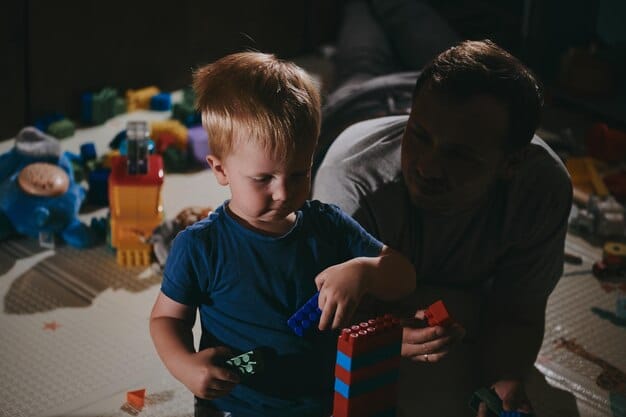Understanding Autism Spectrum Disorder: Early Signs, Diagnosis, and Support Resources

Navigating childhood development often introduces complex territories, and understanding autism spectrum disorder (ASD) involves recognizing early indicators, seeking accurate diagnoses, and accessing robust support systems to foster optimal outcomes for affected individuals and their families.
In the intricate tapestry of human development, some threads present unique patterns. Among these, Understanding Autism Spectrum Disorder: Early Signs, Diagnosis, and Support Resources emerges as a topic of paramount importance. This guide aims to shed light on ASD, offering a comprehensive look at its early manifestations, the diagnostic process, and the crucial network of support available to families and individuals.
Understanding Autism Spectrum Disorder: A Foundational Overview
The journey to comprehending autism spectrum disorder begins with a foundational understanding of what it entails. ASD is a complex neurodevelopmental condition characterized by challenges in social interaction, communication, and often, by restricted or repetitive behaviors. It’s crucial to recognize that “spectrum” truly means a wide range of presentations; no two individuals with ASD are exactly alike. This variability makes a one-size-fits-all approach to understanding or supporting ASD highly ineffective. Instead, a nuanced perspective is required, focusing on individual needs and strengths.
Historically, ASD was conceptualized differently, often categorizing conditions like Asperger’s Syndrome and Pervasive Developmental Disorder, Not Otherwise Specified (PDD-NOS) as distinct entities. However, the Diagnostic and Statistical Manual of Mental Disorders, Fifth Edition (DSM-5), published by the American Psychiatric Association, consolidated these into the single diagnosis of autism spectrum disorder. This shift reflects a more cohesive understanding that these conditions share a common genetic and neurological basis, varying primarily in severity and the presence of intellectual and language impairments. Embracing this spectrum approach allows for more inclusive and flexible diagnostic and intervention strategies.
What Defines Autism Spectrum Disorder?
Defining ASD involves identifying key characteristics across several core domains. These characteristics typically manifest in early childhood, though they might not be recognized until later in life, especially in individuals with milder presentations.
- Social Communication and Interaction Challenges: This includes difficulties with reciprocal social interactions, such as trouble initiating or maintaining conversations, understanding non-verbal cues (like facial expressions or body language), and developing peer relationships appropriate for their developmental level.
- Restricted, Repetitive Patterns of Behavior, Interests, or Activities: These can range from repetitive motor mannerisms (e.g., hand flapping), insistence on sameness or rigid adherence to routines, highly restricted, fixated interests that are abnormal in intensity or focus, to unusual sensory experiences (e.g., hypersensitivity to sounds or hyposensitivity to pain).
The combination and severity of these traits are what contribute to the “spectrum.” Some individuals might have significant language delays and intellectual disabilities, while others might possess exceptional verbal abilities and average or above-average intelligence, often termed “high-functioning autism.” Understanding this breadth is the first step toward effective intervention and support.
Early Signs and Developmental Milestones: What to Look For
Recognizing the early signs of autism spectrum disorder is paramount for timely intervention, which can significantly improve outcomes. These signs often become detectable between 12 and 24 months of age, though some subtle indicators might be present even earlier. Parents, caregivers, and pediatricians play a critical role in observing these developmental nuances. It’s not about identifying one isolated behavior, but rather a pattern of absent or atypical development across multiple domains.
Developmental milestones serve as a crucial guide. While every child develops at their own pace, consistent absence of certain milestones or the appearance of atypical behaviors warrants further investigation. Early indicators often involve subtle differences in social communication and interaction, which are foundational for a child’s learning and engagement with the world. Paying close attention to how a child responds to their environment, interacts with others, and expresses themselves can provide valuable clues.
Key Early Indicators Across Developmental Stages
Specific signs tend to become more apparent as a child grows. Understanding these age-specific indicators can help parents and professionals identify potential concerns.
- Before 12 Months:
- Lack of babbling by 12 months.
- No gesturing (pointing, waving goodbye) by 12 months.
- Lack of eye contact when spoken to or when interacting.
- No response to their name by 12 months.
- 12-24 Months:
- No single words by 16 months.
- No two-word phrases by 24 months.
- Loss of previously acquired speech, babbling, or social skills.
- Lack of pretend play.
- Minimal sharing of enjoyment or interest and achievements with others (e.g., not pointing out interesting objects).
- Beyond 24 Months:
- Avoids eye contact and prefers to be alone.
- Difficulty understanding people’s feelings; difficulty expressing their own.
- Delayed language development or repetitive use of language (echolalia).
- Upset by minor changes in routine; obsessive interests in certain topics.
- Unusual reactions to how things sound, smell, taste, look, or feel.
It is important to remember that the presence of one or two of these signs does not automatically mean a child has ASD. However, if multiple indicators are present or if a parent has persistent concerns, seeking professional evaluation is the most responsible next step. Early detection allows for the earliest possible access to interventions that can foster significant developmental gains.
The Diagnostic Process: From Initial Concerns to Official Diagnosis
The path to an official diagnosis of autism spectrum disorder is a multi-step process, typically involving a team of specialists. It begins with initial concerns, often raised by parents, teachers, or pediatricians, and progresses through screening, comprehensive evaluation, and ultimately, diagnosis. This process is designed to be thorough and nuanced, reflecting the complex nature of ASD and the importance of accurate assessment for effective intervention planning. A timely and accurate diagnosis is crucial because it unlocks access to specialized services and support, which are most effective when started early.
The diagnostic journey can feel overwhelming for families, but understanding each stage can help alleviate some anxiety. It’s a collaborative effort, with the family’s insights and observations being invaluable components throughout. The goal is not just to label, but to understand the child’s unique profile of strengths and challenges, paving the way for tailored support.
Stages of Diagnosis and Key Assessments
The diagnostic process typically unfolds in several stages:
- Developmental Screening: This is a brief assessment done by a pediatrician during routine check-ups. It involves asking parents specific questions about their child’s development or using standardized questionnaires, such as the Modified Checklist for Autism in Toddlers (M-CHAT). A positive screening result does not mean a child has ASD but indicates a need for further evaluation.
- Comprehensive Diagnostic Evaluation: If a screening raises concerns, the child will be referred for a more in-depth evaluation by a team of specialists. This team might include a developmental pediatrician, child psychologist, speech-language pathologist, and occupational therapist. The evaluation involves:
- Developmental History: A detailed review of the child’s medical and developmental history, including interviews with parents about their observations of the child’s behaviors and development from birth.
- Direct Observation: Structured and unstructured observations of the child’s behavior, communication, and social interactions in various settings. Standardized observational tools, like the Autism Diagnostic Observation Schedule (ADOS), may be used.
- Psychological and Cognitive Testing: Assessments to evaluate cognitive abilities, adaptive skills, and to rule out other conditions.
- Speech and Language Assessment: Evaluation of communication skills, both verbal and non-verbal.
The specialists compile information from all these assessments to determine if the child meets the diagnostic criteria for ASD as outlined in the DSM-5. They also assess for co-occurring conditions, which are common in individuals with ASD. The diagnostic report provides a detailed profile of the child’s strengths and challenges, forming the basis for individualized intervention plans.
Multidisciplinary Approach to Intervention and Support
Once an autism spectrum disorder diagnosis is made, the focus shifts to intervention and support. Given the wide range of manifestations of ASD, a multidisciplinary approach is essential. This means combining various therapies and educational strategies tailored to the individual’s specific needs, strengths, and challenges. The goal of intervention is not to “cure” autism, but to maximize an individual’s potential, improve their quality of life, and facilitate their integration into society. Early, intensive, and sustained intervention is generally associated with better outcomes.
The scope of support extends beyond formal therapies to include family support, educational accommodations, and community resources. Creating a supportive ecosystem around the individual with ASD is as crucial as the therapies themselves. This holistic approach acknowledges that every aspect of an individual’s life, from communication to sensory processing, contributes to their overall well-being and ability to thrive.
Key Therapeutic Interventions and Educational Support
A comprehensive intervention plan often incorporates several therapeutic modalities.
- Applied Behavior Analysis (ABA): Widely recognized, ABA is a structured approach that focuses on teaching new skills and reducing challenging behaviors by analyzing antecedents and consequences of behavior. ABA programs are highly individualized and can address a broad range of skills, including communication, social skills, and daily living skills.
- Speech-Language Pathology: Addresses both spoken and non-spoken communication challenges. Therapists work on improving articulation, understanding and using language, social communication skills (e.g., turn-taking in conversations), and alternative communication methods (e.g., picture exchange communication systems – PECS).
- Occupational Therapy (OT): Helps individuals develop skills needed for daily living and participation in meaningful activities. OT can address fine motor skills, gross motor skills, sensory processing difficulties (e.g., hypersensitivity to textures or sounds), and self-care routines.
- Social Skills Training: These group or individual sessions teach specific social behaviors, such as understanding social cues, initiating conversations, or perspective-taking, in a structured and supportive environment.
- Educational Support: Children with ASD often benefit from individualized education programs (IEPs) in school settings, which outline specific goals, accommodations, and services. This may include specialized classrooms, one-on-one aide support, or inclusive settings with appropriate modifications.
Beyond these, family therapy, counseling, and parent training programs are also vital components, empowering families to become active participants in their child’s development and well-being. The effectiveness of these interventions is frequently enhanced when parents are equipped with strategies to generalize skills learned in therapy to everyday situations.
Navigating School and Education: Inclusive Practices and IEPs
For children with autism spectrum disorder, the educational environment plays a pivotal role in their development. Navigating the school system requires understanding rights, advocating for appropriate services, and fostering an inclusive setting. The Individuals with Disabilities Education Act (IDEA) in the US mandates that children with disabilities receive a Free Appropriate Public Education (FAPE) in the Least Restrictive Environment (LRE). This means that, to the maximum extent appropriate, children with disabilities should be educated with children who are not disabled.
The cornerstone of educational support for students with ASD is the Individualized Education Program (IEP). This legal document outlines specific educational goals, services, and accommodations designed to meet the unique needs of each student. Crafting an effective IEP requires active collaboration between parents, educators, and relevant specialists. It’s a dynamic document, reviewed at least annually, to ensure it continues to address the student’s evolving needs.
Components of an Effective Individualized Education Program (IEP)
An IEP is a comprehensive plan that details the educational journey for a student with ASD.
- Present Levels of Academic Achievement and Functional Performance (PLAAFP): Describes how the child is currently doing in school and how their disability affects their involvement and progress in the general education curriculum.
- Annual Goals: Measurable academic and functional goals designed to meet the child’s needs resulting from the disability. These goals should be specific, measurable, achievable, relevant, and time-bound (SMART).
- Special Education and Related Services: Lists the specific educational services, therapies (e.g., speech, occupational, physical), and support services (e.g., behavioral support, social skills groups) the child will receive.
- Extent of Participation in General Education: Explains the extent to which the child will not participate with non-disabled children in the regular classroom, if applicable, and why.
- Accommodations and Modifications: Details changes in teaching methods, materials, or environment (accommodations) or changes to the curriculum itself (modifications) to help the child access learning. Examples include extended time on tests, preferential seating, or reduced assignments.
- Transition Services: For older students, the IEP also includes a plan for transitioning from school to post-school activities, such as higher education, employment, or independent living.
Effective IEP implementation relies on open communication and partnerships between families and the school system. Parents are crucial members of the IEP team, bringing invaluable insights into their child’s strengths, communication styles, and needs outside of school. Advocacy, participation, and a proactive approach are key to ensuring children with ASD receive the education and support they deserve.

Support Systems and Resources for Families and Caregivers
Living with and supporting an individual with autism spectrum disorder impacts the entire family. Therefore, establishing robust support systems and accessing comprehensive resources is not just beneficial but often essential for the well-being of families and caregivers. Beyond the direct therapeutic interventions for the individual with ASD, parents and siblings also need avenues for understanding, emotional support, and practical guidance. The journey can be challenging, but a strong network can transform it into one of shared growth and resilience.
These support systems come in many forms, from formal organizations providing advocacy and information to informal peer groups offering emotional solace and practical tips. The goal is to ensure families feel empowered, informed, and connected, rather than isolated. Access to accurate information, shared experiences, and professional guidance can significantly reduce stress and improve coping strategies.
Types of Support and Key Resources
A wide array of resources is available to assist families and caregivers.
- Advocacy Organizations: Organizations like Autism Speaks, the Autism Society of America, and local autism associations provide a wealth of information, advocacy services, and direct support to families. They often offer helplines, educational materials, and local chapter meetings.
- Parent Support Groups: Connecting with other parents who are navigating similar experiences can be incredibly validating and informative. These groups, whether in-person or online, offer a safe space to share challenges, celebrate successes, and exchange practical advice.
- Respite Care: Providing temporary relief for primary caregivers, respite care can prevent burnout and allow families to recharge. Many organizations offer direct respite services or can help families find qualified providers.
- Financial and Legal Guidance: Navigating the costs associated with therapies and services can be daunting. Resources exist to help families understand insurance coverage, government programs (like Medicaid waivers), and special needs trusts, as well as legal aspects related to guardianship or estate planning.
- Therapist and Specialist Directories: Websites and organizations often provide directories to locate qualified developmental pediatricians, therapists (ABA, SLP, OT), and other specialists in their local area.
Beyond these, online forums, social media groups, and community workshops also serve as valuable platforms for information sharing and emotional support. Families are encouraged to explore various options to find what best fits their unique needs and circumstances, fostering a sense of community and shared purpose in their journey with ASD.
The Lived Experience: Perspectives from Individuals with ASD and Their Families
Understanding autism spectrum disorder goes beyond scientific definitions and therapeutic strategies; it requires acknowledging the rich and diverse lived experiences of individuals on the spectrum and their families. These personal narratives offer invaluable insights into the daily realities, triumphs, and challenges encountered. Moving beyond stereotypes, these voices highlight the importance of neurodiversity—the concept that variations in the human brain are natural and valuable, rather than deficits. Embracing this perspective fosters environments of acceptance, inclusion, and celebration of unique abilities.
Listening to individuals with ASD provides crucial perspectives on how they perceive and interact with the world, their communication preferences, sensory sensitivities, and intellectual strengths. Similarly, family perspectives shed light on the emotional, logistical, and advocacy aspects of supporting a loved one with ASD throughout their lifespan. These narratives underscore the need for person-centered approaches that respect individual autonomy and promote self-determination.
Diverse Voices: Insights from the ASD Community
The tapestry of the ASD experience is woven with many threads, each unique.
- Neurodiversity Movement: Many individuals on the spectrum, particularly those who are self-advocates, champion the neurodiversity movement. This perspective views autism not as a disease to be cured, but as a natural variation in human neurology. Advocacy shifts from “fixing” the individual to creating environments that are more accommodating and understanding of their unique needs and strengths. It emphasizes respect, acceptance, and inclusion.
- Sensory Sensitivities: A common theme is sensory processing differences. Individuals with ASD may experience hypersensitivity (over-responsiveness) or hyposensitivity (under-responsiveness) to sensory input. A loud environment, certain textures, or bright lights can be overwhelming, while others might seek specific sensory input. Understanding and accommodating these differences is key to creating comfortable and functional environments.
- Communication Styles: Communication varies widely. Some individuals are non-speaking and rely on alternative and augmentative communication (AAC) devices or methods. Others are highly verbal, but might engage in repetitive speech (echolalia), have difficulty with abstract language, or struggle with social nuances in conversation. Respecting and adapting to an individual’s preferred communication style is fundamental.
- Strengths and Talents: The narrative of ASD is increasingly highlighting the unique strengths and talents often associated with the condition. These can include exceptional attention to detail, strong logical reasoning, excellent memory, a deep focus on specific interests, and unique problem-solving abilities. Recognizing and nurturing these strengths can lead to fulfilling academic and professional careers.
By listening to and amplifying these diverse voices, we move towards a more compassionate and inclusive society that values every individual’s contribution. It encourages a shift from mere awareness to genuine understanding and meaningful support.

Future Directions in Autism Research and Advocacy
The understanding of autism spectrum disorder is continuously evolving, driven by ongoing research and dedicated advocacy efforts. The landscape of autism is dynamic, with scientists delving deeper into its genetic and neurological underpinnings, and advocates pushing for greater inclusion, accessibility, and improved services. These future directions promise to refine diagnostic tools, develop more targeted interventions, and ultimately enhance the quality of life for individuals with ASD across their lifespan. This forward momentum is crucial as the prevalence of ASD continues to be recognized globally, emphasizing a growing need for comprehensive solutions.
Research focuses not only on prevention and early intervention but also on understanding the aging process for individuals with ASD, the challenges faced in adulthood, and the co-occurrence of other medical or mental health conditions. Advocacy, meanwhile, champions policy changes, promotes neurodiversity, and works towards dismantling societal barriers.
Key Areas of Focus for the Future
Several key areas are shaping the future of ASD understanding and support.
- Genetic and Neurological Research: Scientists are making significant strides in identifying specific genes and complex gene interactions that contribute to ASD, as well as understanding differences in brain structure and function. This research aims to inform more precise diagnostics, potentially leading to earlier risk identification and the development of highly targeted interventions.
- Personalized Interventions: Recognizing that ASD is highly heterogeneous, future interventions are moving towards highly personalized approaches. This involves leveraging genetic, neurological, and behavioral data to match individuals with the most effective therapies for their unique profile, maximizing positive outcomes.
- Adult Services and Supports: There is a growing recognition of the need for improved services for adults with ASD, including employment support, independent living options, and mental health services. This focus ensures that supports extend beyond childhood, promoting lifelong well-being and participation in society.
- Technology in Intervention: Technological advancements are playing an increasing role, with the development of apps, virtual reality (VR) environments, and wearable devices to assist with communication, social skills training, and sensory regulation. These tools offer innovative and engaging ways to deliver interventions.
- Neurodiversity Affirming Practices: The neurodiversity movement continues to gain momentum, shifting the focus from “fixing” autism to creating a society that accepts, accommodates, and values neurodivergent individuals. This includes promoting inclusive education, employment practices, and public spaces.
These ongoing efforts in research and advocacy are critical for fostering a future where individuals with autism spectrum disorder can truly thrive, with their unique contributions recognized and celebrated within inclusive communities.
| Key Aspect | Brief Description |
|---|---|
| 👀 Early Signs | Watch for atypical development in social interaction, communication, and repetitive behaviors, especially before ages 2-3. |
| 🩺 Diagnosis Process | Involves developmental screening followed by a comprehensive evaluation by a multidisciplinary team. |
| 🤝 Support Resources | Families benefit from advocacy organizations, parent support groups, respite care, and financial/legal guidance. |
| 🧠 Interventions | Includes ABA, speech/occupational therapy, social skills training, and individualized education programs (IEPs). |
Frequently Asked Questions about ASD
In infants, early signs can be subtle but include a lack of consistent eye contact, not responding to their name by 12 months, little to no babbling by 12 months, and absence of gestures like pointing or waving. These indicators suggest a need for further developmental screening.
Diagnosis involves a comprehensive evaluation by a multidisciplinary team, including developmental pediatricians and psychologists. This process typically combines detailed developmental history taking, direct observation using standardized tools like ADOS, and various cognitive and speech assessments to align with DSM-5 criteria.
Support for families is extensive, encompassing advocacy organizations such as Autism Speaks, local parent support groups, and respite care services. Financial and legal guidance, along with therapist directories, are also crucial resources that help families navigate the complexities of ASD care.
Absolutely. Early intervention, starting as soon as a diagnosis is considered, is critically important. Intensive and individualized therapies like Applied Behavior Analysis (ABA), speech therapy, and occupational therapy can significantly improve developmental outcomes, communication skills, and adaptive behaviors, allowing children to reach their full potential.
Schools are essential partners, compelled by laws like IDEA to provide a Free Appropriate Public Education. This is largely achieved through Individualized Education Programs (IEPs) that tailor academic goals, specific services, and accommodations to meet the unique learning needs of students with ASD in the least restrictive environment possible.
Conclusion
The journey of understanding autism spectrum disorder is a continuous process, marked by evolving scientific insights, personal narratives, and dedicated advocacy. From recognizing the subtle early signs and navigating the thorough diagnostic process to accessing a rich tapestry of support resources and specialized interventions, every step contributes to fostering a more inclusive and supportive environment. This comprehensive approach empowers individuals with ASD to thrive, ensuring they receive the tailored support needed to achieve their fullest potential, while also enriching the lives of their families and communities. The collective effort to embrace neurodiversity and champion personalized care promises a brighter future for all on the spectrum.





